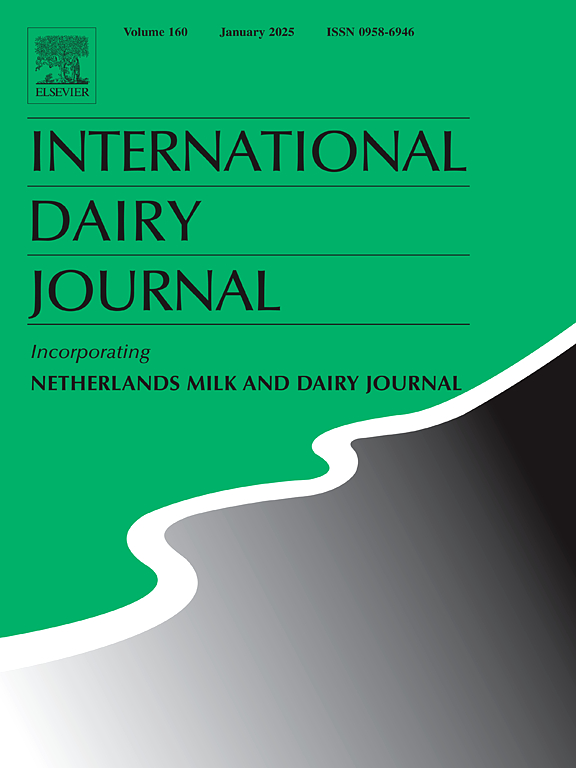Effect of sonication time on physical and foaming properties of pasteurized milk
IF 3.1
3区 农林科学
Q2 FOOD SCIENCE & TECHNOLOGY
引用次数: 0
Abstract
This study investigates the impact of ultrasonication duration on the properties of milk foam. Milk samples were subjected to ultrasonication for varying durations (1, 3, 5, 7, and 10 min), resulting in different sizes of native fat globules (249.5, 221.5, 222.6, 207.5, and 244.8 nm, respectively). The results indicate that viscosity increases as fat globule size decreases, with slight effect on zeta potential. NanoFoamer was identified as the optimal method providing the highest between foamability and stability (p < 0.05). Notably, foaming performance decreases after 7 min of sonication, highlighting the importance of selecting an appropriate frothing method to achieve the desired foam characteristics. Comparisons with non-ultrasonicated milk suggest that ultrasonication duration not only influences foamability by reducing fat globule size but also enhances foam stability through alterations in the fat globule sizes. Analysis of the foam structure revealed that smaller fat globules initially produce smaller, more numerous air bubbles with polyhedral shapes and well-defined lamellae. However, excessive reduction in fat globule size destabilizes the foam due to competitive protein adsorption and altered membrane composition, resulting in larger, less stable bubbles over time. Exploring ultrasonication times to enhances quality of milk and foam properties, offering significant benefits for dairy processing, product innovation and customer satisfaction.
超声时间对巴氏杀菌奶物理和发泡特性的影响
本研究探讨了超声处理持续时间对牛奶泡沫特性的影响。对牛奶样品进行不同持续时间(1、3、5、7 和 10 分钟)的超声处理,产生了不同大小的原生脂肪球(分别为 249.5、221.5、222.6、207.5 和 244.8 纳米)。结果表明,粘度随着脂肪球尺寸的减小而增加,但对 zeta 电位的影响很小。纳米发泡剂被认为是发泡性和稳定性最佳的方法(p < 0.05)。值得注意的是,发泡性能在超声 7 分钟后会下降,这突出了选择适当的发泡方法以获得理想的泡沫特性的重要性。与非超声处理牛奶的比较表明,超声处理的持续时间不仅会通过减小脂肪球的大小来影响发泡性,还会通过改变脂肪球的大小来增强泡沫的稳定性。对泡沫结构的分析表明,较小的脂肪球最初会产生更小、更多的气泡,气泡呈多面体形状,层状结构清晰。然而,由于蛋白质的竞争性吸附和膜成分的改变,脂肪球尺寸的过度缩小会破坏泡沫的稳定性,从而导致气泡体积变大,稳定性降低。探索超声时间可提高牛奶质量和泡沫特性,为乳制品加工、产品创新和客户满意度带来显著效益。
本文章由计算机程序翻译,如有差异,请以英文原文为准。
求助全文
约1分钟内获得全文
求助全文
来源期刊

International Dairy Journal
工程技术-食品科技
CiteScore
6.50
自引率
9.70%
发文量
200
审稿时长
49 days
期刊介绍:
The International Dairy Journal publishes significant advancements in dairy science and technology in the form of research articles and critical reviews that are of relevance to the broader international dairy community. Within this scope, research on the science and technology of milk and dairy products and the nutritional and health aspects of dairy foods are included; the journal pays particular attention to applied research and its interface with the dairy industry.
The journal''s coverage includes the following, where directly applicable to dairy science and technology:
• Chemistry and physico-chemical properties of milk constituents
• Microbiology, food safety, enzymology, biotechnology
• Processing and engineering
• Emulsion science, food structure, and texture
• Raw material quality and effect on relevant products
• Flavour and off-flavour development
• Technological functionality and applications of dairy ingredients
• Sensory and consumer sciences
• Nutrition and substantiation of human health implications of milk components or dairy products
International Dairy Journal does not publish papers related to milk production, animal health and other aspects of on-farm milk production unless there is a clear relationship to dairy technology, human health or final product quality.
 求助内容:
求助内容: 应助结果提醒方式:
应助结果提醒方式:


